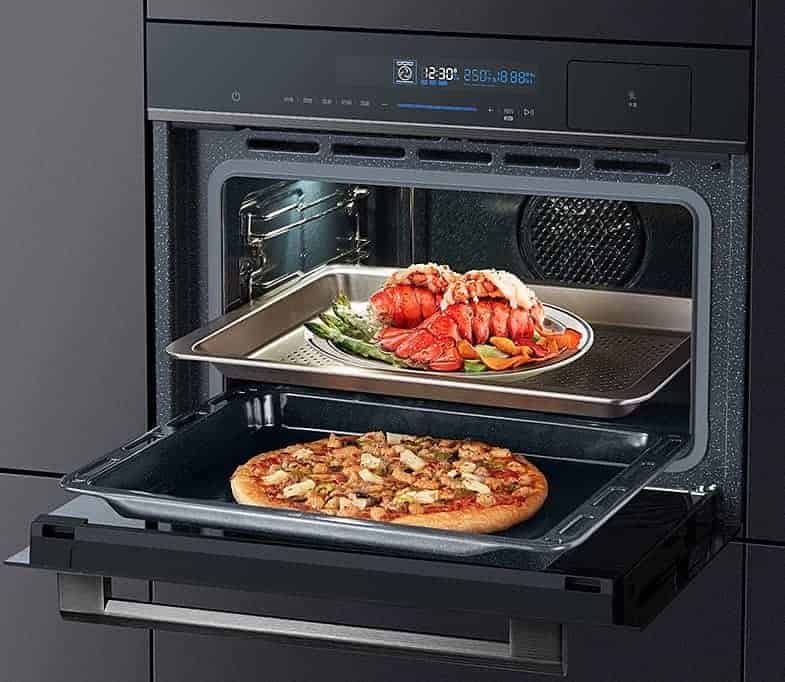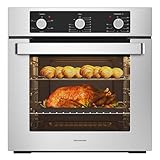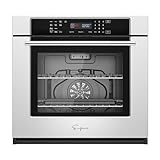How to Choose the Best Wall Oven?

Table of Contents
Top Best Wall Ovens Based on Reviews and Price
How to Choose a Wall Oven?
The wall oven fits in harmoniously with the kitchen, in a cabinet or under a work surface. The wall oven is, therefore, above all, an aesthetic choice. But, unlike its freestanding counterpart, it helps to optimize space.
The wall oven is popular with cooking enthusiasts, novices and the experienced. But choosing a built-in wall oven is not easy. There are many models with more or fewer features, available at different prices. This article serves to guide you to choose a wall oven that suits your needs and budget.
10 Factors to Consider Before Buying a Wall Oven
1. Type of Wall Ovens
The first decision to make will be the type of wall oven you are going to buy.
Natural Convection Wall Ovens
It is considered as the classic ovens. The air inside the cavity is heated by 2 resistances: the vault resistance (top) and the sole resistance (bottom). Air flows freely from top to bottom. These ovens are very easy to use. They offer efficient cooking for all your traditional dishes. However, they require preheating to heat the walls and increase the overall temperature of the oven.
Convection Ovens
Convection ovens are equipped with an additional circular resistance that will accompany the fan turbine at the bottom of the oven. Thus, the heat will spread uniformly throughout the cavity through the turbine.
Air Circulation Ovens
Air circulation ovens work in the same way as natural convection ovens. The only difference is the addition of a ventilation turbine which will allow the air in the cavity to be stirred to provide more even cooking of the food.
Steam Wall Ovens
These ones heat food with steam rather than by the radiation of one or more resistors. The resulting cooking is often smoother and evener. The cooking temperature is moderate, between 40 and 100°C. This limits the destruction of vitamins and minerals while retaining the original taste of the food. This cooking is not reserved for vegetables. However, it can be used to cook meat or fish. The cooking time is usually longer, but the texture of the food will be more tender.
Combi-steam/Convection Wall Ovens
These ovens users combine the precision and uniformity of the circulating heat with the smoothness and quality of steam-cooking.
2. Gas or Electricity?
For Gas Oven
You will not always have the option of equipping yourself with a wall gas oven. This depends on where you live, the regulations in force or even your facilities. In fact, to have this type of oven in your kitchen, you will need two things:
- A connection to your city’s gas supply
- A thermocouple device built into the oven to automatically stop the gas when the flame goes out. It’s a security measure.
For Electric Ovens
In addition, you should also know that electric ovens tend to be energy-consuming. In fact, there are two things to watch out for:
- First of all, check that your electrical installation is not defective.
- Make sure you buy an oven with a good energy rating; A+ rated appliance, at least.
3. Capacity to Choose
The capacity of an oven depends above all on usage and available space. A wall oven compatible with standard niche furniture has an average volume of between 50 and 80 liters. This capacity is generally sufficient for a family of two to six people.
There are, however, larger capacity ovens. But beware, they are only compatible with specific built-in niches around 90 cm wide. Remember to check the outside dimensions of the oven.
Compact wall ovens also exist. Their cavity displays a volume of between 38 and 45 liters. They fit into niches 45 cm high identical to those used for built-in microwave ovens.
4. Door Options
You will often use the door of your wall oven. You will find below the different options that can be compatible with your lifestyle and make things easier for you.
- Drop-down wall oven: Folding door ovens are the most classic models. The opening is from top to bottom. This type of door is particularly suitable if your oven is placed under the worktop or at your height.
- Side door oven: The side doors are particularly suitable when the oven is located high enough. They allow you to have good visibility to monitor the cooking of dishes easily.
- Oven with drawer door or outgoing rack: The drawer door, also called outgoing cart door, is only available on built-in wall models. It opens like a drawer. The cavity has no steps. The grids and dishes are fixed on a fastening system secured to the door. When the drawer door is open, the dishes, therefore, slide outwards with it.
- Pocket door oven: The pocket door oven, also called retractable, slides under the oven enclosure when opening. This type of opening is mainly found in the German brand Neff under the name “Slide & Hide”. It saves space and lets you get as close as possible to the cooking chamber. Ovens with a retractable door are generally sold at a slightly higher price.
5. Energy Consumption
When buying an electric wall oven, be sure to check its energy label. You will find in the label its energy rating. This is usually between A+++ and D. Preferably choose an oven with a good energy rating. The latter will allow you to make real energy savings over time, even if the device is more expensive to buy.
On this same label, also look at the kWh/cycle. This gives you an indication of the kWh per operating cycle, regardless of the cooking mode used.
6. Lighting System
Another important point is the lighting. This is essential to monitor the cooking of dishes properly. It can be placed at the top of the cavity, in the vault or at the side walls. Ensure that it is not dangling when the door is open.
The bulb can be incandescent, halogen or LED. Note that some models incorporate a lighting system in the door. For optimal lighting, remember that you’ll have to clean the protective glass regularly.
7. Glass Door
The glass door offers the possibility of monitoring the cooking of dishes through the glass, without touching the oven. Some are completely transparent; others are screen printed, making them more opaque. So-called “mirror” doors can be of aesthetic interest but sometimes limit interior visibility.
You have to regularly clean the interior and exterior windows to maintain good visibility of the interior of the cavity.
8. Safety Features
There are several security features you should watch out for when selecting your wall oven. These include:
- The cold door: This consists of three to four glass walls, cooled by air circulation. It thus offers greater security, in particular against contact burns, especially if the oven is located under your worktop or if you have children. It is particularly relevant on ovens equipped with pyrolysis cleaning.
- Locking controls: Some ovens are fitted with a control lock. This function prevents disturbing the oven once programmed. It can also be used as a child safety device if the control panel is accessible to the little ones.
- The anti-tilt grid: Some ovens are fitted with an anti-tilt grid, an outgoing carriage or telescopic rails. These facilities facilitate access to dishes. You can, for example, water your roast without having to hold the dish, thus providing better security.
9. Automatic Cleaning Mode
There are different automatic cleaning modes available in wall ovens. Do consider this feature if necessary for your needs. Each has different characteristics:
- Pyrolysis cleaning: When you switch on this cleaning system, the oven starts to heat at a very high temperature, reaching almost 500°C. With such heat, organic grease and debris are literally reduced to ashes. All that remains (after the device has completely cooled down) is to wipe it off with a damp sponge or cloth.
- Catalytic cleaning: Ovens with a catalytic cleaning system have micro-porous enameled walls that remove fat during cooking. These ovens are generally less expensive and efficient than pyrolysis. However, it will always be necessary to regularly clean the oven manually to get rid of all the residues.
- Steam cleaning: This cleaning mode is one of the most economical and its operation is straightforward. The heated water will condense on the walls of the cavity. It will remove all of the dirt, grease and other accumulated dirt. All you have to do is swipe the walls with a quick sponge when the cleaning cycle is finished.
10. Other Useful Features
There are many other functions you can look out for in a built-in wall oven. Although you might not use all of these features, keep in mind that these features are important. It makes a wall oven to be easier when using:
- Automatic programming: It allows you to program temperature and cooking time, depending on the dish you want to cook. Self-programming ovens generally offer between 20 and 80 programs. To go further, some interactive programmers allow you to select the information concerning the food you wish to cook (the type of dish, weight, etc.) before offering you the best suitable cooking.
- Cooking probe: Some ovens can be fitted with a cooking probe. This probe is planted in the food you want to cook. It will follow the temperature of the food in real-time and stop cooking when the optimal temperature is reached.
- Touchscreen: It facilitates the daily use of your oven. Intuitively, it allows you to choose the cooking program for your dishes easily.
- Cavity separator: The cavity separator allows you to cook two dishes simultaneously at two different temperatures without mixing odors between the two cavities. This accessory is often available on large capacity ovens.
- Connected ovens: Some wall ovens have a Wi-Fi connection. This allows you to follow the cooking process and change the cooking mode remotely. However, it is still impossible to start the oven remotely as this poses obvious safety problems.
Wrapping It Up
Choosing a wall oven doesn’t have to be a headache! The price does not always reflect the quality of the wall oven, which is why this guide is important. If you use your oven occasionally, you don’t have to choose a model with many features. The models with pyrolysis cleaning systems are the most effective, but also the most expensive.
A wall oven is used almost every day: so check its electrical consumption. Check the space and cabinet you have for the installation. Choose a door opening adapted to the space and layout of your kitchen. Consider the safety features, especially if you have curious kids around.
With these points put into consideration, you are going to get your money’s worth!











